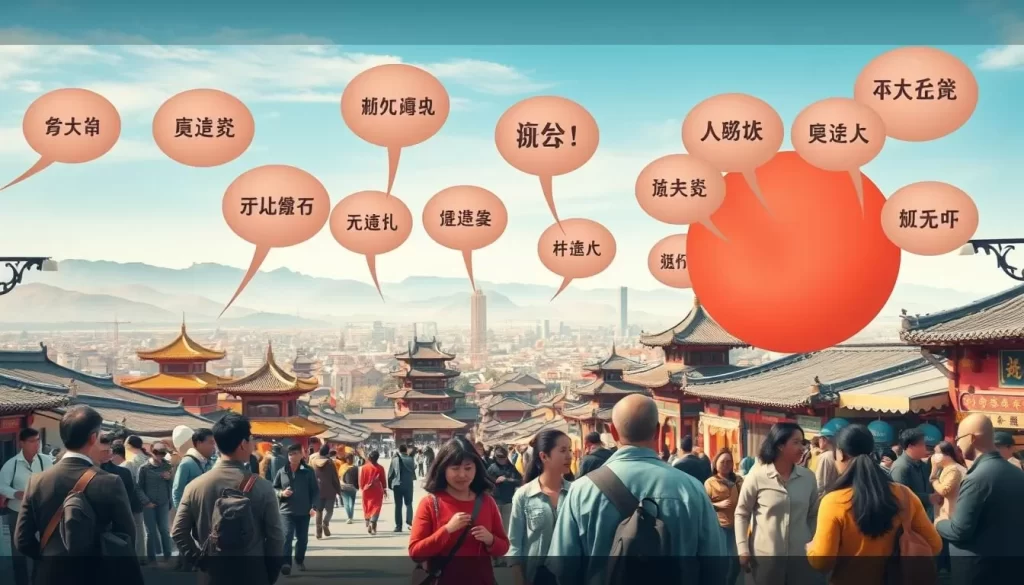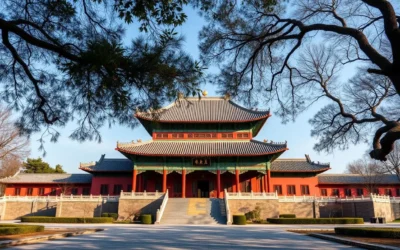✓ Accommodations✓ Flights✓ Rental Cars✓ Tours & Activities ✓ Tours & Activities
Did you know that over 1.4 billion people call this region home? It’s a place where linguistic diversity thrives, with hundreds of dialects and minority languages adding to its cultural richness. At the heart of this ecosystem is Standard Chinese, based on the Beijing dialect, spoken by about 92% of the population.
While Mandarin Chinese dominates, other dialects like Cantonese, Wu, and Hakka are spoken by millions. Each one reflects unique regional identities and histories. This variety makes the language family one of the most fascinating in the world.
Ready to dive deeper? This article will guide you through the intricate world of dialects, their distribution, and how they shape the cultural landscape. Let’s explore together!
Introduction: Discover China’s Linguistic Landscape
Dive into a world where language tells the story of culture and history. Over 955 million people speak a variety of Mandarin, making it the most widely used dialect. This linguistic diversity reflects a rich heritage that spans centuries.
Diversity and Rich Heritage
The linguistic landscape is a mosaic of dialects and minority languages. From Cantonese to Tibetan, each one carries unique cultural significance. For example, Tibetan is a co-official language in its region, showcasing the government’s support for minority traditions.
Quick Facts and Population Insights
Mandarin dominates with over 70% of the population using it daily. However, dialects like Wu and Hakka are spoken by millions, adding to the region’s linguistic richness. Here’s a quick look at key dialects and their speakers:
| Dialect | Speakers (Millions) | Region |
|---|---|---|
| Mandarin | 955 | Nationwide |
| Cantonese | 73 | Guangdong, Hong Kong, Macau |
| Wu | 80 | Shanghai, Zhejiang |
| Hakka | 80 | Southern regions |
This diversity is not just about numbers. It’s about how language shapes identity and connects communities. Whether in schools or public spaces, dialects play a vital role in daily life.
China: Official and widely spoken languages – A Comprehensive List
Exploring the many dialects reveals a fascinating world of communication. With nearly 302 individual living languages, this region is a treasure trove of linguistic diversity. Each dialect and language group carries its own unique history and cultural significance.

An Overview of Spoken Varieties
Mandarin dominates as the most widely used dialect, with over 70% of the population speaking it daily. However, other dialects like Cantonese, Wu, and Hakka are spoken by millions. These varieties reflect regional identities and traditions.
Written forms of communication remain mutually intelligible across dialects. This unity in writing helps bridge the gap between different speech patterns.
Key Dialects and Their Global Impact
Some dialects have gained international recognition. Cantonese, for example, is widely spoken in Hong Kong and Macau. It has also influenced communities worldwide, from Chinatowns to global media.
Here’s a quick look at the most influential dialects:
- Mandarin: The official language, spoken by over 900 million people.
- Cantonese: A key dialect in southern regions and overseas communities.
- Wu: Prominent in Shanghai and surrounding areas.
- Hakka: Known for its unique phonetic features.
These dialects not only shape local identities but also contribute to the global cultural landscape.
Official Language Policy and Government Influence in China
Language policies in this region have shaped education and cultural identity for decades. The government plays a key role in promoting Mandarin as the primary language in schools, while also addressing the needs of minority groups.
How Policies Shape Language Education
Since 1956, Mandarin has been the main language taught in schools. This policy ensures that students across the country can communicate effectively. By third grade, minority students must follow the national curriculum, which is taught in Mandarin.
Bilingual programs exist in regions like Tibet and Inner Mongolia. These programs aim to balance national unity with cultural preservation. However, challenges like a lack of qualified teachers and resources can affect their success.
Effects on Minority Language Use
Minority languages face significant challenges. While laws protect their use in local government and media, many are at risk of fading away. Urbanization and economic development often favor Mandarin, leading to a shift among younger generations.
Here are some key impacts on minority languages:
- Education: Minority languages are often taught as extracurricular subjects, reducing their prominence in schools.
- Cultural Identity: The decline of minority languages can erode cultural traditions and heritage.
- Community: Language loss can weaken community bonds and intergenerational communication.
Efforts to preserve these languages, like bilingual programs in Yunnan province, show promise but require more support.
Standard Chinese: The Lingua Franca of Mainland China
Standard Chinese bridges communication across diverse regions, uniting millions. Based on the Beijing dialect, it serves as the common lingua franca in education, media, and daily interactions. Over 80% of the population can speak it, making it the most widely used spoken language in the region.
The Role of Mandarin in Daily Life
From classrooms to boardrooms, Mandarin Chinese plays a pivotal role. It’s the primary language in schools, ensuring students nationwide can communicate effectively. In business, it fosters collaboration across different dialect groups, simplifying interactions in a diverse linguistic landscape.
Socially, it connects people from various backgrounds. Whether you’re in a bustling city or a rural village, Standard Chinese is the go-to language for clear communication.
Understanding Pinyin and Writing Systems
Pinyin, the Romanization system, is essential for learning pronunciation. It helps beginners master the sounds of Standard Chinese, making it easier to speak and understand. For example, the word “你好” (nǐ hǎo) is pronounced using Pinyin as a guide.
Writing systems vary between traditional and simplified Hanzi. Simplified characters are used in Mainland China, while traditional forms are common in Hong Kong and Taiwan. Here’s a quick comparison:
| Form | Usage | Example |
|---|---|---|
| Simplified | Mainland China, Singapore | 爱 (love) |
| Traditional | Hong Kong, Taiwan, Macau | 愛 (love) |
These systems ensure written communication remains consistent, even across different dialects.
Regional Language Gems: Cantonese, Hakka, and More
Discover the vibrant regional dialects that shape the cultural identity of millions. These linguistic treasures reflect the rich heritage of their respective regions, offering a unique glimpse into local traditions and history.
Spotlight on Cantonese in Hong Kong and Macau
Cantonese is a prominent dialect in Hong Kong and Macau, where it serves as a cornerstone of daily communication. Over 80% of Macau’s population speaks Cantonese, making it the dominant language in the region.
This dialect is known for its nine tones, which add complexity and expressiveness to its pronunciation. Its widespread use in media and entertainment has also given it global recognition, influencing communities far beyond its native regions.
Exploring Other Chinese Dialects
Beyond Cantonese, other dialects like Hakka and Shanghainese hold significant cultural value. Hakka, spoken by millions in southern regions, is known for its unique phonetic features.
Shanghainese, part of the Wu dialect group, is prominent in Shanghai and surrounding areas. Its distinct pronunciation and word usage reflect the local identity of its speakers.
Here’s a quick comparison of these regional dialects:
| Dialect | Region | Key Features |
|---|---|---|
| Cantonese | Hong Kong, Macau | Nine tones, global influence |
| Hakka | Southern regions | Unique phonetic structure |
| Shanghainese | Shanghai | Distinct pronunciation, local identity |
These dialects are more than just ways of speaking—they are a testament to the diversity and resilience of regional cultures. Whether through their unique pronunciation or cultural significance, they continue to thrive in modern society.
Minority Languages and Their Unique Cultures
The rich tapestry of minority languages in this region reflects centuries of cultural heritage. These linguistic treasures are more than just ways of communication—they are vital to preserving the identity of ethnic groups like Mongolians, Tibetans, and Uyghurs.

Preservation of Mongolian, Tibetan, and Uyghur Traditions
Mongolian, Tibetan, and Uyghur languages are deeply tied to their respective cultures. For example, the Yi ethnic group has its own unique script and rich oral tradition, showcasing efforts to maintain their language. Similarly, the Inner Mongolia Autonomous Region teaches Mongolian alongside Mandarin in its education system.
Government initiatives aim to establish cultural centers and promote minority languages in media and literature. However, challenges like limited access to quality teaching resources and insufficient teacher training can hinder these efforts.
Here’s a quick look at some key minority languages and their regions:
| Language | Region | Key Features |
|---|---|---|
| Mongolian | Inner Mongolia | Unique script, bilingual education |
| Tibetan | Tibet | Rich oral tradition, co-official status |
| Uyghur | Xinjiang | Arabic script, Turkic roots |
These languages are not just tools for communication—they are windows into the history and traditions of their speakers. For instance, Yunnan Province is noted as one of the most linguistically diverse regions, home to several minority languages including Yi, Bai, and Hani.
Digital platforms and language learning apps are being developed to enhance the learning of minority languages, such as Uighur and Tibetan. These efforts are crucial for ensuring that these linguistic varieties continue to thrive in modern society.
Historical Evolution of Chinese Languages
The evolution of Chinese languages spans thousands of years, shaped by dynasties and cultural shifts. From the Shang dynasty to modern times, each era has left its mark on the way people communicate. This journey reveals how language adapts to societal changes while preserving its core identity.
The Impact of Dynasties and Classical Chinese
During the Shang dynasty, Old Chinese emerged as the earliest recorded form. This language laid the foundation for written communication, with oracle bone inscriptions providing a glimpse into its structure. Over time, the Zhou dynasty introduced Classical Chinese, which became the standard for literature and official documents.
By the Tang dynasty, Middle Chinese had developed, characterized by its tonal system and complex pronunciation. This period marked a significant shift in how people spoke and wrote, influencing later dialects. The Ming and Qing dynasties further refined the language, paving the way for modern forms.
Journey Through the Sinicization Process
Sinicization played a crucial role in unifying diverse dialects under a common linguistic framework. This process began during the Han dynasty and continued through the centuries, integrating regional variations into a cohesive system.
For example, the transition from Old Chinese to Standard Mandarin involved simplifying pronunciation and standardizing grammar. This made the language more accessible to a broader population. Today, Standard Mandarin serves as the lingua franca, bridging communication across different regions.
To learn more about this fascinating journey, explore the history of the Chinese language and its cultural significance.
The Significance of Dialects in Education and Daily Life
Understanding the role of dialects in education and daily life reveals their deep cultural significance. These linguistic forms are not just ways of speaking—they are vital to preserving regional identities and connecting communities.

Regional Schools and Language Programs
Many regional schools offer bilingual programs that teach both Standard Chinese and local dialects. This approach ensures students can communicate nationally while retaining their cultural heritage. For example, in Guangdong Province, Cantonese is taught alongside Mandarin, reflecting its importance in daily life.
These programs often face challenges, such as limited resources and teacher training. However, they play a crucial role in maintaining linguistic diversity. By integrating dialects into the curriculum, schools help students appreciate their cultural roots.
Here’s how bilingual programs benefit education:
- Cultural Identity: Students learn to value their regional heritage through language.
- Communication Skills: Bilingualism enhances cognitive abilities and social interactions.
- Community Connection: Local dialects strengthen bonds within communities.
In classrooms, teachers often use dialects to explain complex concepts, making learning more relatable. This practice not only aids comprehension but also fosters a sense of belonging among students.
To explore more about the linguistic diversity in this region, discover how dialects shape education and daily life.
Learning Chinese: Opportunities for Cultural Exchange
Learning Chinese opens doors to new cultures and career opportunities. As the most widely spoken language in the world, Mandarin Chinese connects over 1.2 billion people. Whether you’re exploring personal growth or professional advancement, mastering this language can transform your life.
Global Career Benefits and Language Skills
Proficiency in Chinese can boost your career prospects globally. With the second-largest economy in the world, businesses value employees who can communicate effectively in Mandarin. For example, programs like LoPair Culture Exchange offer intensive courses lasting up to a year, preparing you for real-world applications.
Language skills also enhance cultural understanding. Programs at CET Academic Programs run four hours daily, Monday through Friday, ensuring immersive learning. This approach helps you grasp not just the word but also the cultural nuances behind it.
Emerging Trends in Language Learning
Modern methods are making Chinese more accessible. Online courses and apps allow you to practice pronunciation and vocabulary at your own pace. For instance, XMandarin has tailored courses since 2006, serving thousands of international students.
Language exchange programs are another trend. They emphasize spending equal time on both languages, starting with 20-minute sessions to build confidence. This method helps you master the tonal variety of Mandarin, which can be challenging for beginners.
“Learning Chinese isn’t just about the language—it’s about connecting with a rich cultural heritage.”
If you’re considering a deeper dive, explore Chinese language immersion programs. These programs offer structured environments to practice and improve your skills while experiencing the culture firsthand.
Exploring Written Chinese: Scripts from Ancient to Modern
The written Chinese language has evolved over millennia, reflecting cultural and historical shifts. From ancient inscriptions to modern characters, this journey reveals how writing systems adapt while preserving their core identity.

From Hanzi to Simplified and Traditional Characters
Chinese writing began with Hanzi, ancient characters inscribed on bones and shells during the Shang dynasty. These early forms laid the foundation for a rich literary tradition.
Over time, traditional characters evolved, becoming the standard for centuries. However, in the 1950s, Mainland China adopted simplified characters to improve literacy rates. This change reduced stroke counts, making writing easier for the general population.
For example, the character for “love” went from 13 strokes (愛) to just 6 (爱). This simplification reflects broader efforts to make the language more accessible.
Regional Variations in Written Forms
While simplified characters dominate in Mainland China, traditional forms remain prevalent in Taiwan and Hong Kong. These regional differences highlight the diverse cultural identities within the Chinese-speaking world.
Written Chinese also serves as a unifying force. Despite variations in spoken dialects, the written form remains mutually intelligible. This shared system bridges communication across different regions.
Here’s a comparison of simplified and traditional characters:
| Character | Traditional | Simplified | Stroke Count |
|---|---|---|---|
| Love | 愛 | 爱 | 13 → 6 |
| Electricity | 電 | 电 | 13 → 5 |
| Open | 開 | 开 | 12 → 5 |
| Book | 書 | 书 | 16 → 8 |
These variations illustrate how written Chinese adapts to societal needs while preserving its historical roots. To learn more about the written Chinese language, explore its fascinating evolution and cultural significance.
Conclusion
The linguistic landscape of this region is a testament to its rich cultural heritage. From Standard Chinese to regional dialects, each form of communication tells a unique story. These variations reflect centuries of history and the influence of government policies.
In schools and workplaces, this diversity fosters connection and understanding. Learning these languages opens doors to cultural exchange and career opportunities. For example, mastering Mandarin can enhance global communication skills.
Whether you’re exploring dialects or written scripts, this journey offers valuable insights. Dive deeper into the world of language to appreciate its profound impact on culture and identity. Discover more about this fascinating topic here.
The above is subject to change.
Check back often to TRAVEL.COM for the latest travel tips and deals.






